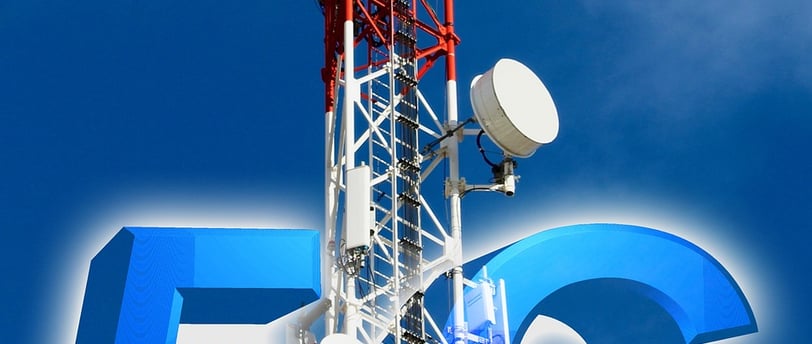Windway Logistics | Logistics and Transportation Solutions
How 5G Technology is Revolutionizing the Logistics Industry
Explore how 5G technology is set to enhance connectivity, tracking, and automation in logistics.
9/19/20244 min read


Introduction
The transportation sector is on the brink of a technological breakthrough, and 5G technology is leading the way in this evolution. With its ability to deliver faster speeds, lower latency, and better connectivity, 5G technology promises to enhance every part of supply chain management, from tracking in real-time to automating warehouses. In this piece, we'll delve into how 5G technology is transforming the transportation industry and redefining the future of supply chain connectivity.
1. Improved Real-Time Tracking and Visibility
A key advantage of 5G technology in transportation is its capacity to offer superior real-time tracking of shipments and assets. Thanks to its enhanced bandwidth and low latency, transportation companies can monitor the movement of goods with high precision and accuracy. This increased visibility facilitates quicker decision-making, minimizes the chance of lost or delayed deliveries, and boosts customer satisfaction.
Key Advantages of 5G in Real-Time Tracking:
- Continuous updates: 5G networks provide ongoing, real-time updates on the location of shipments, simplifying the management of delays or changes in routes.
- Better asset tracking: Transportation providers can more effectively track vehicles, containers, and individual items, ensuring greater transparency throughout the supply chain.
- Enhanced customer experience: With precise tracking information, customers can receive more accurate delivery estimates and notifications in real-time.
2. Faster and More Reliable Communication
Effective communication is crucial for a well-functioning supply chain, and 5G technology significantly boosts logistics connectivity. Faster communication among drivers, warehouse staff, and distribution centers streamlines logistics operations and cuts down on downtime.
How 5G Boosts Communication in Logistics:
- Instant updates among teams: Warehouse employees and transportation operators can communicate in real-time, leading to faster decision-making and better coordination.
- Greater IoT device usage: 5G technology supports a broader application of Internet of Things (IoT) devices in the logistics field, enabling real-time data gathering and device communication.
- Effortless video and voice communication: With 5G, logistics teams can use high-definition video for remote problem-solving, enhancing operational efficiency.
3. Revolutionizing Warehouse Automation
5G supply chain innovations extend to warehouse automation, where speed, precision, and efficiency are critical to meeting the growing demands of e-commerce and global trade. 5G enables smoother communication between automated systems and robots within warehouses, improving operational efficiency and reducing human error.
Benefits of 5G-Powered Warehouse Automation:
- Faster data transfer: 5G allows warehouse automation systems to process and transmit data faster, improving the efficiency of robots, automated guided vehicles (AGVs), and other machinery.
- Improved warehouse management systems (WMS): With 5G, warehouse management systems can receive real-time data from automated systems, ensuring optimal inventory management and reducing downtime.
- Smarter robotic systems: Robotics powered by 5G can work more efficiently, improving picking and packing processes and accelerating order fulfillment.
4. Enhancing Vehicle Fleet Management Efficiency
Managing a group of delivery vehicles is a challenging task that demands up-to-the-minute information on where the vehicles are, how much fuel they're using, and the current state of traffic. 5G logistics offers a solution to this challenge by providing fast data transfer and quick communication, allowing logistics firms to fine-tune their routes, lower fuel expenses, and enhance delivery schedules.
Key Benefits of 5G for Vehicle Fleet Management:
- Efficient route planning: Thanks to real-time traffic updates and predictive analytics made possible by 5G, fleet managers can plan delivery routes more effectively, avoiding delays and cutting down on fuel use.
- Predictive maintenance: Vehicles equipped with 5G-enabled IoT sensors can keep an eye on their performance in real-time, notifying managers to potential maintenance issues before they escalate.
- Reduced fuel costs: By making routes more efficient and minimizing idle time, logistics companies can decrease fuel usage, saving money and reducing their environmental impact.
5. Supporting Autonomous Vehicles and Drones
The future of 5G supply chain management includes the broad adoption of autonomous vehicles and drones for deliveries. The ultra-low latency and high-speed capabilities of 5G are essential for these technologies to function effectively, as they rely on instant data exchange to navigate complex environments and make rapid decisions.
How 5G Supports Autonomous Vehicles and Drones:
- Precise navigation: 5G facilitates precise, real-time communication among autonomous vehicles, drones, and central control systems, ensuring safe and efficient movement.
- Faster delivery times: Drones and autonomous vehicles powered by 5G can deliver goods more quickly in city areas, offering same-day or even same-hour delivery options.
- Improved safety: The dependability and speed of 5G ensure that autonomous systems can make safer choices, reducing the likelihood of accidents and enhancing the overall safety of logistics operations.
6. Enhancing Supply Chain Resilience
The COVID-19 pandemic underscored the need for resilient supply chains. 5G logistics can significantly contribute to building supply chain resilience by providing immediate insights, enhancing communication, and enabling quicker responses to disruptions.
How 5G Strengthens Supply Chain Resilience:
- Immediate access to data for faster decision-making: In the face of a disruption, 5G-enabled systems offer instant access to data, allowing logistics providers to swiftly adjust to new situations.
- More accurate demand forecasting: 5G’s capacity to support AI and machine learning technologies allows logistics companies to refine demand forecasting and inventory management, minimizing the impact of disruptions.
- Remote monitoring and control: With 5G, logistics managers can oversee and manage warehouse and fleet operations from a distance, ensuring operations continue even when unexpected challenges arise.
Conclusion
5G technology is poised to revolutionize the logistics industry by enhancing real-time tracking, improving communication, and supporting advanced automation and autonomous systems. As 5G logistics becomes more widespread, companies that embrace this technology will enjoy faster, more reliable, and more efficient supply chains. From warehouse automation to fleet management, 5G supply chain innovations are reshaping the future of logistics, helping businesses meet growing demands while staying competitive in an increasingly digital world.
Your One-Stop Shop for Logistics Solutions.
Contact
Follow
Support@windwaycentralogistics.com
+2347069986074
© 2024. All rights reserved.
+2347042141892
+233540806857
* Badagry expressway, Alafia Bus stop, behind Oando filling station( Bencord Warehouse),Lagos, Nigeria.
* Atiku Abubakar Hall, Balogun Trade Fair market, Lagos, Nigeria
* Abossey-Okai Mortuary Road, Opposite the Central Mosque, Ghana.


